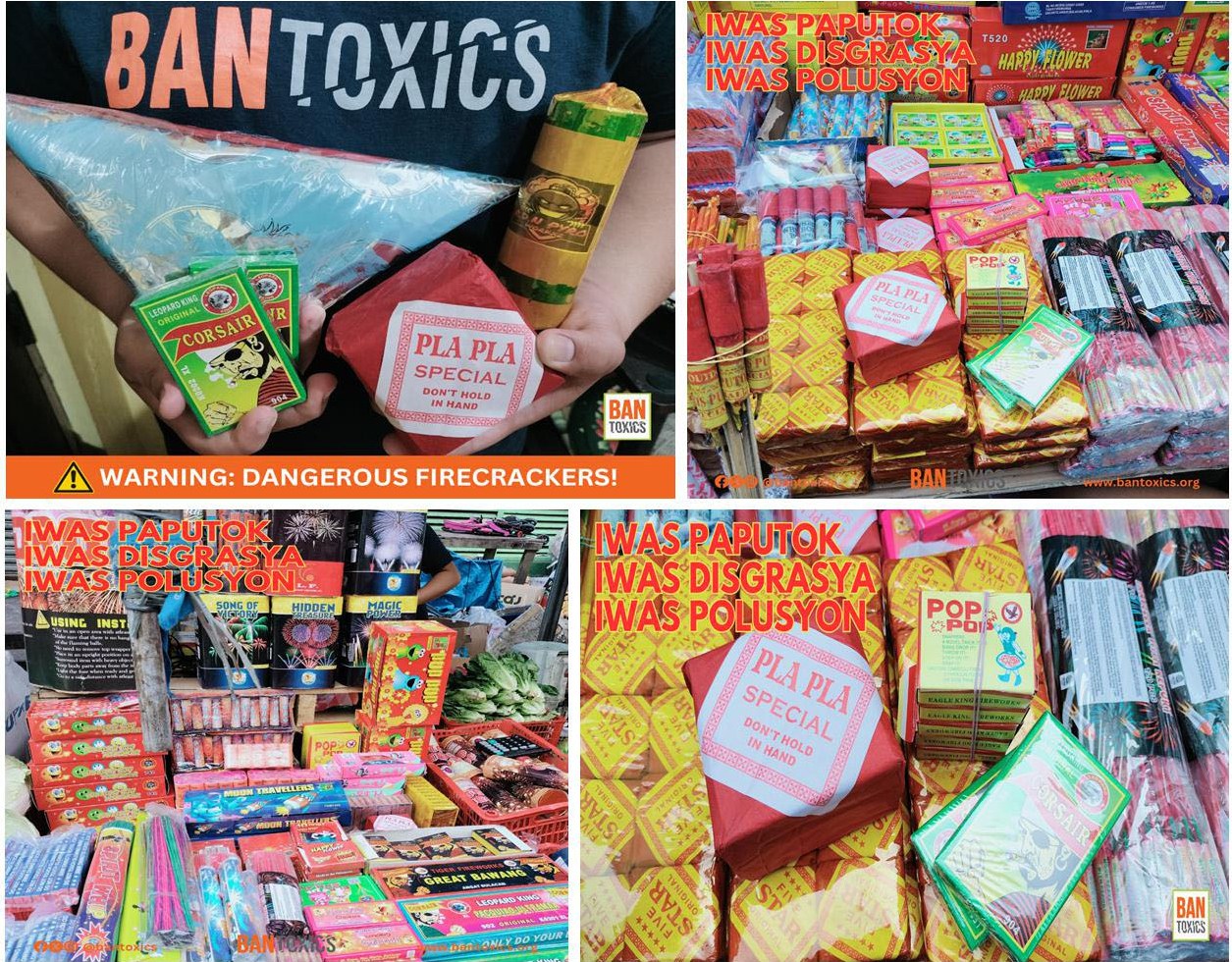Urgent Call to Action: Toxic Watchdog Group Urges PNP and Local Officials to Confiscate Hazardous Illegal Firecrackers

Five days before New Year’s Eve, the toxic watchdog group BAN Toxics has urgently called upon the Philippine National Police (PNP) and the Local Government Units (LGUs) to address the rampant sale of prohibited and hazardous firecrackers. Merchants are currently showcasing various noise-makers, firecrackers, and fireworks, raising concerns about public safety.
Prohibited firecrackers have consistently been identified as a major culprit in firecracker-related injuries in recent years. During the recent “Iwas Paputok” monitoring conducted by BT Patrollers on December 26 in Tabora and M. de Santos Street in Divisoria, the group documented and purchased various illegal firecrackers, including Atomic, Piccolo in various sizes, Special Pla-pla packs of ten, Whistle Bombs, Bawang and Five-Star, and even a “Dugong” – a triangular firecracker measuring 12 by 8.5 inches, obtained discreetly from an ambulant store.
“We urge the PNP and LGUs to intensify on-site monitoring and confiscating illegal firecrackers as New Year’s Eve approaches,” said Thony Dizon, Toxics Campaigner of BAN Toxics.
“Itong patuloy na pagbebenta ng mga illegal na paputok ay sadyang nakakabaha at nakakatakot kung ito ay napasakamay ng publiko, lalo na ng mga bata. Peligroso ang mga paputok sa kalusugan at maging sa ating kalikasan,” Dizon explained.
The continuous sale of these illegal firecrackers poses a significant threat, especially to children. Firecrackers are not only hazardous to health but also detrimental to the environment.
Recent reports indicate a surge in firecracker-related injuries, with 52 cases recorded from December 22-26, just days before New Year’s Eve celebrations. The National Capital Region reported 20 cases, Region 3 logged six, and Region 12 recorded five. The Health Secretary highlighted 11 instances of Firework-Related injuries (FWRI) in residential areas, with other cases occurring on streets and at an assigned area for fireworks displays.
To support the prevention of firecracker-related injuries in the country, the group launched the “Iwas paputok, Iwas disgrasya, Iwas polusyon” campaign in partnership with the school, local officials, and representatives from the Philippine National Police and Bureau of Fire Protection, urging the public not to use firecrackers and promote a toxic-free and waste-free New Year’s celebration.
To prevent firecracker-related injuries, BAN Toxics expressed its support to the call of DILG Secretary Benhur Abalos to ban the sale and use of firecrackers nationwide and urge the LGUs to enforce the existing firecracker ban and regulations as well as enact ordinances banning the use and sale of firecrackers.
On December 19, the DILG issued a Memorandum Circular (2023-202) urging cities and municipalities to pass ordinances and issue regulations banning individual, personal, or household use of any kind of firecrackers.
“We must shift away from the traditional harmful use of firecrackers. ‘Safety first, Health first’ for our children and the community is crucial to make our celebration of New Year’s Eve a safer one,” said BAN Toxics.
To prevent firecracker-related injuries, especially among children, the group urges the public to refrain from spending money on toxic, waste, and pollution-driven firecrackers and fireworks. Instead, they promote the use of alternative noisemakers such as shakers made from old plastic containers, tambourines fashioned from used bottle caps, pots and pot lids, and maracas created from recycled cans for a safer and healthier New Year’s celebration.”
Firecrackers also pose significant harm to our animal companions, particularly dogs, cats, and other animals around us. The sudden and jarring noises from firecrackers can be deeply distressing for them. Studies indicate that up to 50 percent of dogs exhibit a fear of firecrackers and fireworks. The high-intensity noise affects animals more severely than humans due to their heightened hearing sensitivity, inducing fear and anxiety. Continual exposure to such abrupt and unpredictable loud noises can lead to phobias in many animals, increasing their panic. ### (PR)
References:
DILG Memorandum Circular 2023-202:
https://www.dilg.gov.ph/PDF_File/issuances/memo_circulars/dilg-memocircular-20231222_9b06073701.pdf







